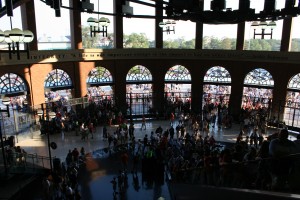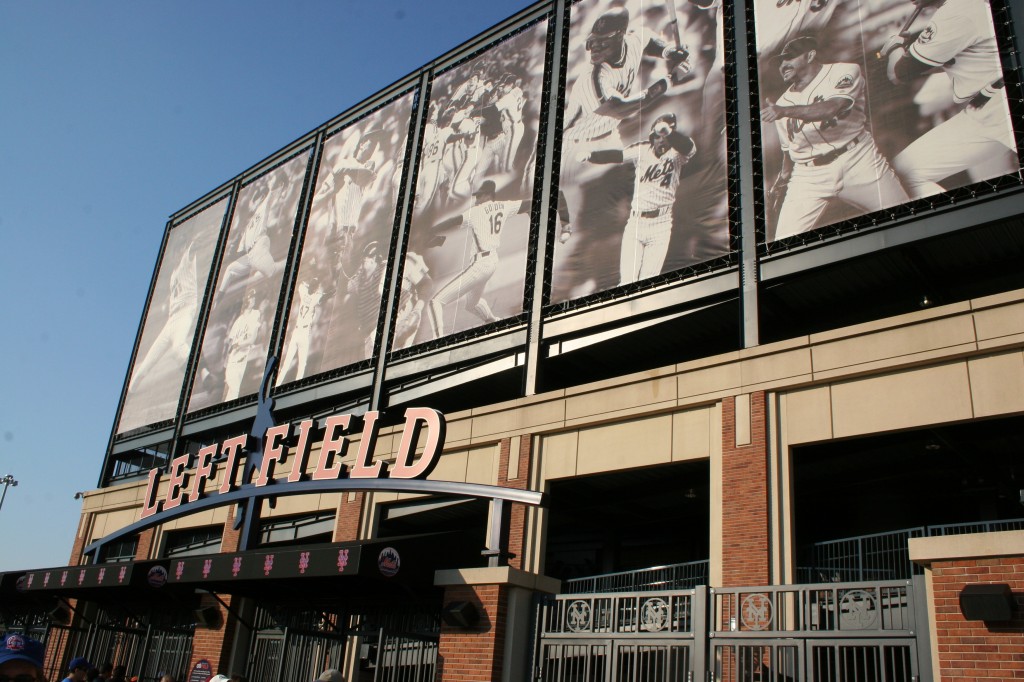Stadium Review: Citifield
Sitting in the bleachers at Citifield, home of the New York Mets, is a world away from watching a game across the East River at Yankee Stadium.
Just getting there takes 45 minutes by subway train, taking you far from the skyscrapers of Manhattan to the relatively open space of Queens. Given its proximity to LaGuardia airport, the drone of planes is in constant competition with the organ as opposed to the bass-heavy hip-hop and rock played by the Yankees.
Most striking of all, the atmosphere is friendly and family-oriented. It's hard to believe that it's the same city.
Although the exterior to Citifield is rather bland, the interior has an eclectic, retro-feel. The seating sections are layered on top of each other and crammed into odd angles, although the seats themselves still have lots of leg room.

The Jackie Robinson Rotunda serves as the main entrance to Citifield and is lined with inspiring quotes from the Hall of Famer.
Spaces like the Jackie Robinson Rotunda tie the history of the Mets to the Brooklyn Dodgers, their spiritual ancestors of in the National League. That retro vibe translates well into Citifield’s concourses that are full of modern concessions modelled to look like traditional ballpark stands.
I attended New York’s heartbreaking 8-6 loss to the Cincinnati Reds on July 5th. Since the Mets hadn’t played on Independence Day, the stadium was in full patriotic splendour. Although the Yankees had a stirring tribute to Lou Gehrig the day before, as well as the traditional singing of God Bless America, the Mets topped them in their Fourth of July celebrations.
Before the opening pitch at Citifield they had members of the U.S.O. singing the anthems of the various divisions of the American armed forces. Then they had a Lieutenant-General swear a group of recruits into the army.
During every stoppage of play they ran video of soldiers from Queens and Brooklyn in Iraq and Afghanistan greeting their families who’d been given seats at the game. It was a touching and heartfelt display, and really illustrated the connection between the Mets, their fans and those serving overseas.
That’s what was nice about the entire Citifield experience – it really balances the old and new and emphasizes the connection between the Mets and their fans in the boroughs of New York City.
Also, as a relatively neutral observer, they succeeded in drawing me in to the game and I found myself rooting for the home team despite myself.
Although Yankee Stadium has more history and significance behind it, as a venue for watching a baseball game I’d take Citifield any day of the week.
A fond farewell to Ken Griffey Jr.
Last night was one of those perfect storms of sports news that happens every month or so.
Armando Galarraga’s perfect game was ruined on the 27th out by a controversial call by umpire Jim Joyce.
Game 3 of the Stanley Cup final went into overtime, with a goal being called back after the puck miraculously rolled across the crease. The no-goal was after National Hockey League Commissioner Gary Bettman got cantankerous with Ron MacLean during the second intermission of Hockey Night in Canada.
But what I’ll always remember about June 2nd 2010 is that Ken Griffey Jr. retired.
As I’ve written before, Griffey was my favourite baseball player growing up.
In his prime he was the best fielder and hitter in the game. In a time when professional athletes develop chips on their shoulders, become arrogant or act out, Griffey remained fun-loving and grounded.
His statistics speak for themselves. Griffey accumulated 630 home runs, the fifth-most in baseball history. He has 2781 hits, 1836 RBIs and a career batting average of .284. Hall of Fame numbers to be sure.
Griffey’s best season was undoubtedly 1997 when he won the American League MVP with the Seattle Mariners. That year he hit .304 while reaching career highs with 56 home runs and 147 RBIs.
As impressive as his numbers are, Griffey will always have the aura of unfulfilled potential. Not because he lacked effort, but because he never played in a World Series, even though his Seattle Mariners had a host of talent including Alex Rodriguez, Randy Johnson and Edgar Martinez.
Because he moved to the Cincinnati Reds, a team that has struggled throughout the 1990s and 2000s, he missed out on further playoff opportunities, including two more American League Championship appearances by Seattle in 2000 and 2001.
Nagging injuries forced Griffey to miss prime years of his career. Between 2002 and 2004 he hit a total 41 home runs while playing in only 206 games over those three seasons.
Although Griffey was great, arguably the best of an entire generation of ballplayers, it will always seem as though he might have had still had some untapped potential.
Despite those lost years, Griffey’s career represents an ideal trajectory that in a perfect world all athletes would follow.
Griffey was a genuinely good guy. Griffey knew he was going to be traded from Seattle in 2000, so he asked to be sent to his hometown Cincinnati Reds, the team his father played for in their Big Red Machine glory days. Given the opportunity to abandon the Reds in favour of a bigger salary with the New York Yankees, Griffey took a smaller contract to stay near his family.
He can also be judged for what he didn’t do. In an era where players like Mark McGwire are being held out of Baseball’s Hall of Fame for their connection to performance enhancing drugs, Griffey remains a first-ballot shoe-in because he’s never been connected to any kind of steroid use.
Although Griffey was a shadow of his former self in his final years with the Reds, Chicago White Sox and again with the Mariners, his legacy on and off the field is exemplary of what all baseball players could be – a role model off the field who actually produces incredible numbers.
Griffey will be missed as player, but he will always have a place in baseball.

